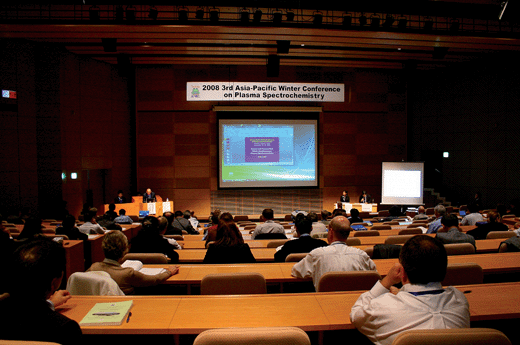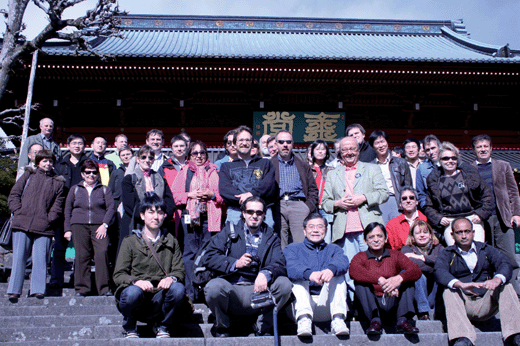DOI:
10.1039/B912946B
(Editorial)
J. Anal. At. Spectrom., 2009,
24, 1141-1144
2008 Third Asia-Pacific Winter Conference on Plasma Spectrochemistry, Tsukuba, Japan, November 16–21
The 2008 Third Asia-Pacific Winter Conference on Plasma Spectrochemistry (2008 APWC) was held at Tsukuba International Congress Center in Tsukuba from November 16th to 21st. This conference was organized by the Discussion Group for Plasma Spectrochemistry in Japan. About 300 scientists participated in the conference from 27 countries worldwide. There were 69 oral presentations, including 1 plenary, 45 invited lectures and 23 contributed presentations, and 110 poster presentations; in total, 180 papers were presented. On Sunday, before the conference started, 8 short courses were conducted (Fig. 1). “An Introduction to ICP-Mass Spectrometry” by Frank Vanhaecke (Ghent University), “ICP-MS with Sector Field Devices” by Norbert Jakubowski (ISAS), “Elemental Speciation Analysis in Biology and Metallomics” by Ryszard Lobinski and Joanna Szpunar (CNRS), “Laser Ablation ICP-MS” by Detlef Günther (ETH Zurich), “Advanced Course in ICP-MS” by Robert S. Houk (Iowa State University), “Application of ICP-MS in the Semiconductor Industry” by Mohammad B. Shabani (SUMICO), “Mass Spectrometry Imaging in Life Sciences” by Alan G. Cox and Josephine Bunch (University of Sheffield), and “Isotope Ratio Measurements by ICP-MS and LA-ICP-MS in the Environment, in Life Science and for Transuranic Studies” by Michael E. Ketterer (Northern Arizona University) and Sabine J. Becker (Research Center Jülich). Since the number of short courses was restricted, we were able to get a large number of attendants for each short course. A plenary lecture was presented by Robert S. Houk entitled “Atomic Spectroscopy Meets Mass Spectrometry” (Fig. 2). He showed high-speed video pictures of ICP when fs-laser ablated particles were introduced into the ICP. He also described new instrumentation combining electrospray ionization, ion/ion reactions and ion mobility for measuring the structure of biomolecules. A get-together party was held at the Congress Center after the plenary lecture (Fig. 3). Keiichiro Fuwa (Emeritus Professor of the University of Tokyo) and Hiroki Haraguchi (Emeritus Professor of Nagoya University) were present. One convention hall was used for oral presentations and a large multi-purpose hall was used for poster presentations and the exhibition. In the exhibition, 38 booths were exhibited by 32 companies. On Monday, Ramon M. Barnes presented “History and Future of the Winter Conference on Plasma Spectrochemistry” (Fig. 4). He looked back at all the Winter Conferences starting from 1980. The subject topics presented on Monday were instrumentation and fundamentals, sample introduction and preparation, alternative plasma sources, glow discharge sources, and environmental/geological applications. The first presenter on Tuesday was Klaus G. Heumann, recipient of the 2007 European Award for Plasma Spectrochemistry. He presented “Species-specific and Species-unspecific Isotope Dilution ICP-MS Hyphenated Techniques for Accurate Determinations of Environmentally and Biogenically Relevant Elemental Species”. The subject topics on Tuesday were focused on elemental speciation: environment, nuclear, marine sciences, and high purity materials including semiconductors. A unique feature of this conference was that there were events organized by manufacturers every evening. Agilent Technologies and PerkinElmer kindly organized evening events on Monday and Tuesday, respectively. Wednesday was a day off and 70 participants enjoyed an excursion to Nikko (Fig. 5). It was a good way to change our mood by taking a break in the middle of the conference, and participants could experience some Japanese culture. At lunchtime, we tasted “tempura” in the Japanese traditional way, sitting on a straw-mat (Fig. 6). On Thursday, the conference resumed with a presentation by Ryszard Lobinski on “Trends in Metallomics: Impact and Limitations of ICP-MS”. The subject topics on Thursday were elemental speciation: metallomics/life sciences, applications to biological/clinical and food/agriculture, and quality control/standards. Half of the posters (57 papers) were presented on Tuesday and the other half (53 papers) were presented on Thursday (Fig. 7). Thermo Fisher Scientific kindly organized an evening event on Thursday. The party was held in Japanese style, serving Sushi and Sake, which encouraged all participants to talk and the atmosphere was very relaxed throughout. On Friday, Frank Vanhaecke presented an invited lecture entitled “Exploiting ICP-MS to its Full Potential by Measuring Isotope Ratios”. The subject topics on Friday were isotope ratio measurements, mass spectrometry imaging, and laser ablation. At the closing ceremony, a total of six poster awards were presented from Journal of Analytical Atomic Spectrometry (JAAS), Analytical and Bioanalytical Chemistry (ABC), and ICP Information Newsletter. It was a hard job for the juries to select the best poster, and I would like to thank them for their efforts. Two JAAS poster awards were selected from posters presented on Tuesday and Thursday. Kohei Nishiguchi (Sumitomo Seika Chemicals Co., Japan) was selected from the Tuesday posters. The title was “On-line Multielement Monitoring of Air Samples Using ICP-Q-MS and ICP-TOFMS Instruments Equipped with Gas Converter Apparatus”. He has developed a gas converter apparatus from air to argon to achieve the direct analysis of airborne particulate matter by ICP-MS. By using the apparatus, the outdoor air sample was directly introduced into the ICP-Q-MS and 40 isotopes (m/z) were monitored every 8 min for 80 hours. From Thursdays posters I-Hsiang Hsu (National Tsing Hua University, Taiwan) was selected. The title was “Nanoparticle-based DNA Sequence Assay by ICP-MS”. He tried to determine the concentration of Dengue virus by analyzing the RNA-conjugated gold nanoparticles. Based on the optimized conditions, 10 femto-molar of the virus sequence could be measured with sufficient reliability. Some papers presented at this conference are assembled in this themed issue of JAAS. It was decided that the Fourth Asia-Pacific Winter Conference will be held in Chengdu, China from November 26th to 30th, 2010. We parted in the hope of meeting again in Chengdu. I would like to thank all the manufacturers who supported this conference and I also thank all the students of Chuo University and the Tokyo Institute of Technology for their assistance to make this conference so successful. |
| | Fig. 1 Eight short courses were conducted on Sunday. | |
 |
| | Fig. 2 A plenary lecture was presented by Prof. Robert S. Houk. | |
 |
| | Fig. 3 A get-together party was held on Sunday. | |
 |
| | Fig. 4 Oral presentations were held at a convention hall on Monday, Tuesday, and Thursday. | |
 |
| | Fig. 5 The Wednesday excursion to Nikko. | |
 |
| | Fig. 6 A Japanese-style lunch at Nikko. | |
 |
| | Fig. 7 Poster presentations were held at a multi-purpose hall on Tuesday and Thursday. | |
Naoki Furuta
On behalf of the Organizing Committee of the 2008 APWC,
Chuo University,
Tokyo, Japan
E-mail: nfuruta@chem.chuo-u.ac.jp
|
| This journal is © The Royal Society of Chemistry 2009 |
Click here to see how this site uses Cookies. View our privacy policy here. 






